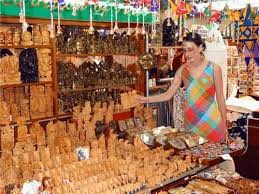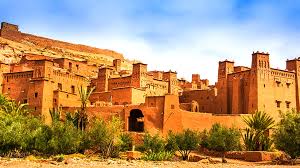The Art of Handicraft Shopping: Exploring Treasures from Around the World
Handicraft shopping is not just about buying souvenirs; it’s a journey into the heart and soul of a culture. From intricate textiles to hand-carved wooden artefacts, each piece tells a story of tradition, craftsmanship, and creativity.
Discovering Unique Treasures
When you step into a bustling handicraft market or visit a local artisan’s workshop, you are transported into a world of unique treasures waiting to be uncovered. Whether you’re in the vibrant markets of Marrakech browsing colourful rugs and leather goods or exploring the serene pottery villages of Japan, each destination offers its own distinct handicraft traditions.
The Craftsmanship Behind Every Piece
What sets handicrafts apart is the dedication and skill that goes into creating each item. From weaving intricate patterns on a loom to meticulously painting delicate ceramics, artisans around the world pour their hearts into their craft. By purchasing handmade goods, you not only acquire a beautiful item but also support local communities and preserve age-old traditions.
Connecting with Culture
Handicraft shopping allows you to connect with the culture and heritage of a place in a tangible way. Each item reflects the customs, beliefs, and aesthetics of its creators, giving you insight into the values that define a society. Whether it’s admiring the geometric motifs of Moroccan tiles or feeling the weight of an Indian brass sculpture in your hands, every purchase becomes a cultural exchange.
Sustainability and Ethical Shopping
In an age where mass-produced goods dominate the market, choosing handmade handicrafts is not only an aesthetic choice but also an ethical one. By supporting artisans who use sustainable materials and traditional techniques, you contribute to environmental conservation and fair trade practices. Handicraft shopping promotes sustainability by valuing quality over quantity and preserving artisanal skills for future generations.
Bringing Home Memories
Every handicraft purchase is more than just an object; it’s a memory encapsulated in material form. Whether it’s a handwoven basket from Bali or a hand-painted mask from Venice, these treasures carry with them the sights, sounds, and scents of your travels. They serve as reminders of adventures past and inspirations for journeys yet to come.
So next time you find yourself in a bustling bazaar or meandering through quaint artisan stalls, take a moment to appreciate the artistry and heritage behind each handicraft piece. Let your purchases be more than mere mementoes—they are windows into diverse cultures and testaments to human creativity that transcend borders.
Essential Guide to Handicraft Shopping: Discovering Authenticity, Navigating Etiquette, and Embracing Sustainability
- What types of handicrafts can I find while shopping?
- Where are the best places to buy authentic handicrafts?
- How can I ensure the quality and authenticity of handmade items?
- Are there any specific etiquettes or customs to follow when buying handicrafts?
- What are some popular souvenir options for handicraft shopping?
- Do artisans in different countries specialise in specific types of crafts?
- Are there any sustainable or eco-friendly options available for handmade products?
- How can I bargain or negotiate prices when purchasing handicrafts?
- Can I participate in any workshops or demonstrations to learn about traditional crafts while shopping?
What types of handicrafts can I find while shopping?
When exploring the world of handicraft shopping, you will encounter a diverse array of artisanal treasures waiting to be discovered. From intricately woven textiles and hand-painted ceramics to finely carved wooden sculptures and delicate metalwork, the types of handicrafts you can find are as varied as the cultures that produce them. Each piece tells a story of tradition, creativity, and craftsmanship, offering a glimpse into the rich tapestry of global artistry. Whether you’re drawn to the vibrant colours of Moroccan rugs, the intricate patterns of Indian textiles, or the elegant simplicity of Japanese pottery, there is a handicraft waiting to capture your imagination and bring a touch of cultural authenticity into your home.
Where are the best places to buy authentic handicrafts?
When seeking authentic handicrafts, the best places to explore are often local markets, artisan workshops, and cultural hubs known for preserving traditional craftsmanship. In destinations like the bustling souks of Marrakech in Morocco, the artisanal villages of Oaxaca in Mexico, or the vibrant markets of Jaipur in India, you can find a treasure trove of authentic handicrafts that showcase the skill and artistry of local artisans. By immersing yourself in these cultural hotspots, you not only discover unique pieces but also support communities dedicated to keeping age-old traditions alive through their craft.
How can I ensure the quality and authenticity of handmade items?
When it comes to ensuring the quality and authenticity of handmade items while handicraft shopping, there are several key factors to consider. Firstly, look for visible signs of craftsmanship such as intricate detailing, fine stitching, and unique designs that showcase the artisan’s skill and dedication. Additionally, inquire about the materials used in the creation of the item to ensure they are of high quality and ethically sourced. Supporting local artisans and purchasing directly from them or reputable fair trade organisations can also help guarantee the authenticity of handmade goods. Lastly, educating yourself about traditional crafting techniques specific to the region can further aid in discerning genuine handmade items from mass-produced imitations. By paying attention to these details and engaging with the local culture, you can enhance your handicraft shopping experience while securing truly authentic treasures.
Are there any specific etiquettes or customs to follow when buying handicrafts?
When engaging in handicraft shopping, it is important to be mindful of specific etiquettes and customs to ensure a respectful and enriching experience. Firstly, it is advisable to show appreciation for the artisan’s work by taking the time to understand the craftsmanship behind each piece. Bargaining is often a common practice in many cultures, but it should be done respectfully and with an awareness of fair pricing. Additionally, asking questions about the materials used, the techniques employed, and the cultural significance of the handicrafts can deepen your connection to the items you wish to purchase. Remember that each purchase is not just a transaction but a meaningful exchange that honours tradition and creativity.
What are some popular souvenir options for handicraft shopping?
When it comes to souvenir options for handicraft shopping, the world is brimming with diverse and captivating choices. From delicate hand-painted ceramics in Italy to vibrant textiles in India, each destination offers its own array of popular keepsakes. Intricately woven baskets from Africa, intricately carved wooden masks from Indonesia, and colourful tapestries from Peru are just a few examples of the treasures you can bring home to cherish memories of your travels. Whether you’re drawn to traditional pottery, embroidered fabrics, or metalwork artefacts, handicraft shopping presents a plethora of popular souvenir options that encapsulate the spirit and artistry of different cultures around the globe.
Do artisans in different countries specialise in specific types of crafts?
Artisans in different countries often specialise in specific types of crafts, showcasing the unique cultural heritage and artistic traditions of their regions. From the intricate filigree work of Italian jewellers to the vibrant textile weaving of Peruvian artisans, each craft reflects a deep-rooted connection to local customs and skills passed down through generations. By focusing on particular techniques and materials indigenous to their surroundings, artisans create masterpieces that not only embody their cultural identity but also highlight the diversity and richness of global handicraft traditions.
Are there any sustainable or eco-friendly options available for handmade products?
When it comes to handmade products, there is a growing demand for sustainable and eco-friendly options among consumers. Many artisans and crafters are embracing environmentally conscious practices by using natural, biodegradable materials, recycling resources, and implementing low-impact production methods. From organic cotton textiles to upcycled jewellery and ethically sourced woodwork, there are plenty of sustainable choices available for those seeking to support both traditional craftsmanship and the planet. By opting for these eco-friendly handmade products, shoppers can not only enjoy unique and beautiful items but also contribute to a more sustainable future for generations to come.
How can I bargain or negotiate prices when purchasing handicrafts?
When it comes to bargaining or negotiating prices while purchasing handicrafts, it’s essential to approach the process with respect and an understanding of local customs. In many cultures, haggling is a common practice and is seen as part of the shopping experience. Start by showing genuine interest in the item and engaging in friendly conversation with the seller. Be prepared to offer a reasonable counter-offer based on your research of the item’s value and quality. Remember that both parties should feel satisfied with the final price, so be willing to compromise to reach a fair deal. Ultimately, bargaining can be a fun and rewarding way to connect with artisans and secure a unique piece at a price that works for both you and the seller.
Can I participate in any workshops or demonstrations to learn about traditional crafts while shopping?
Many destinations around the world offer the unique opportunity for visitors to immerse themselves in the art of traditional crafts through workshops and demonstrations while shopping for handicrafts. From pottery throwing classes in quaint English villages to rug weaving sessions in bustling Moroccan souks, these hands-on experiences allow travellers to not only purchase authentic handmade goods but also gain insight into the intricate processes and skills involved in creating them. By participating in these workshops, you can deepen your appreciation for the art of traditional crafts and take home not just a souvenir, but also a newfound understanding of the cultural heritage embedded within each piece.




